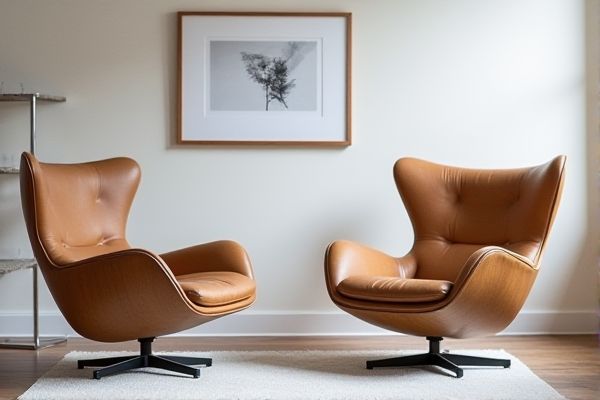
Cantilever chairs offer flexible support with their unique curved frame that allows slight rocking, enhancing comfort, while stationary chairs provide a stable, fixed seating experience ideal for consistent posture. Explore the rest of the article to understand which style best suits Your needs and space.
Table of Comparison
| Feature | Cantilever Chair | Stationary Chair |
|---|---|---|
| Design | Flexible frame with a single continuous base | Rigid frame with four fixed legs |
| Comfort | Provides slight bounce and ergonomic support | Stable seating but less flexible |
| Mobility | Lightweight, easy to move | Heavier, less convenient to relocate |
| Durability | Depends on frame material; may flex over time | Solid and sturdy; less prone to deformation |
| Aesthetic | Modern, sleek appearance | Traditional, classic look |
| Weight Capacity | Typically supports up to 250-300 lbs | Supports higher weight depending on construction |
| Usage | Office, dining, and meeting rooms | Living rooms, offices, general seating |
| Price Range | Moderate to high depending on design | Wide range from low to high |
Introduction to Cantilever and Stationary Chairs
Cantilever chairs are designed with a single, curved support that creates a floating effect, enhancing ergonomic comfort and flexibility. Stationary chairs feature four fixed legs offering stable, immovable support suitable for consistent seating needs. Both chair types prioritize different uses, with cantilever models favored for modern office aesthetics and stationary chairs common in traditional settings.
Design Differences: Cantilever vs Stationary Chairs
Cantilever chairs feature a unique, flexible design with a single bent metal or tubular frame that supports the seat and backrest without rear legs, offering a slight bounce for enhanced comfort. Stationary chairs have a traditional four-leg structure, providing solid stability and a classic appearance without any flexible movement. Your choice depends on whether you prioritize modern aesthetics and dynamic support or firm stability and conventional design.
Ergonomics and Comfort Comparison
Cantilever chairs offer enhanced ergonomic support through their flexible frame that adapts to body movements, reducing pressure points and promoting natural posture. Stationary chairs provide firm, consistent support beneficial for tasks requiring stability but may lack the dynamic comfort of cantilever designs. The choice between them depends on balancing motion-friendly ergonomics with the need for steady seating during prolonged use.
Material Choices and Durability
Cantilever chairs often feature tubular steel frames that provide flexibility and resilience, making them ideal for modern office environments requiring dynamic seating. Stationary chairs typically use solid wood or heavy-duty metal for robust and long-lasting support, enhancing durability in static settings. Your choice depends on whether you prioritize the sleek, flexible design and lightweight materials of cantilever chairs or the sturdy, enduring construction of stationary chairs.
Aesthetic Appeal and Modern Interior Design
Cantilever chairs boast a sleek, minimalist design that enhances modern interior aesthetics with their elegant curves and floating appearance. Stationary chairs offer a more traditional, grounded look that complements classic or transitional decor styles. Your choice hinges on whether you prefer the dynamic, contemporary vibe of cantilever chairs or the timeless stability of stationary seating.
Space Efficiency and Flexibility
Cantilever chairs offer greater space efficiency due to their open underframe design, allowing for easier movement and storage in tight spaces. Stationary chairs provide stability but often occupy more floor area, limiting flexibility in rearranging your workspace or room layout. Choosing a cantilever chair enhances your ability to optimize space without compromising on comfort or style.
Stability and Support: Which Is Better?
Cantilever chairs offer a flexible support system with a slight spring action, enhancing comfort but potentially compromising stability on uneven surfaces. Stationary chairs provide a solid, unwavering base ideal for tasks requiring consistent posture and balance, making them better suited for environments demanding maximum stability. Your choice depends on whether you prioritize dynamic comfort or firm, reliable support in your seating.
Common Applications and Best Use Cases
Cantilever chairs are commonly used in modern office spaces, conference rooms, and waiting areas due to their sleek design and flexibility, offering slight motion that enhances comfort during short to moderate seating periods. Stationary chairs are preferred in dining rooms, classrooms, and workstations where stability and prolonged seating are critical, providing firm support without movement. The choice between the two depends on the need for dynamic support and aesthetic appeal versus static support and durability in everyday use.
Price and Value Considerations
Cantilever chairs generally have a higher upfront cost due to their unique design and materials, offering modern aesthetics and ergonomic benefits that add value to your workspace. Stationary chairs tend to be more affordable and provide stable support, making them a practical choice for budget-conscious buyers. Evaluating your needs for style, comfort, and durability will help you determine which chair delivers the best value for your investment.
Maintenance and Long-Term Care
Cantilever chairs require regular inspection of their metal frame for signs of rust or fatigue, and the flexible base may need occasional tightening or replacement to maintain its ergonomic support. Stationary chairs often demand less frequent mechanical maintenance but may require more attention to cushion wear and fabric cleaning to ensure comfort over time. Your choice influences the extent and type of long-term care needed, with cantilever models generally requiring more specialized metal maintenance compared to the upholstery focus of stationary chairs.
 homyna.com
homyna.com